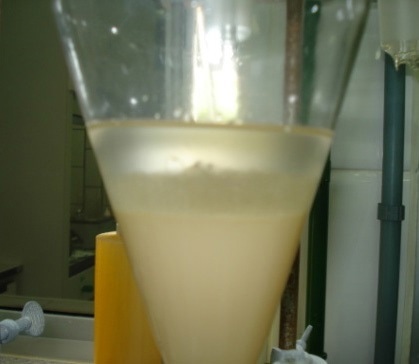Particular types of samples, such as those containing detergent, may create emulsions when doing an oil-in-water extraction into a solvent. The boundary between the sample and the solvent will have an emulsion layer that has a milky or cloudy appearance as shown in the below image. According to U.S. EPA Method 1664, “if the emulsion is greater than one-third the volume of the solvent layer, the laboratory must employ emulsion-breaking techniques to complete the phase separation.” This is applicable to all oil in water measurements that employ liquid-liquid extraction, whether the analysis is performed by UV, gravimetric or infrared.
If this type of emulsion cannot be broken by any attempted processes, the test method may not provide the representative results for the problem sample. The best approach to reduce or break the emulsion depends on the sample matrix.

Useful Options for Reducing Emulsion
The following options may be useful for sufficiently reducing the emulsion to take a valid measurement.
1. Let the sample sit. The easiest way is to let the sample to sit for up to an hour and observe whether the emulsion decreases or remains stable. Ensure that the sample is covered tightly to reduce any evaporation of the solvent. Gently stirring the solvent and emulsion layer with a stir bar or tapping the side of the container can help accelerate the separation.
2. Acidify the sample. If the emulsion occurs due to a surfactant, detergent or alkali soap, then reducing the pH to 2 with hydrochloric acid (HCl), or sulfuric acid (H2SO4), (as recommended in the grease and oil methods, mainly for preservation of the sample) will alter the surfactant’s charge such that it no longer serves as an emulsifier.
3. Add table salt (NaCl). If users know that their sample forms emulsion, they can add the salt to the sample before shaking with the solvent. If users are attempting to break an already formed emulsion, they should shake the salt into the sample. Hopefully, the salt dropping to the bottom will be seen as the droplets from the emulsion coalesce and the emulsion disappears into cleanly partitioned layers. In addition, sodium sulfate can be sprinkled into the sample as illustrated above, or potassium pyrophosphate as illustrated in the next section can be used.
4. Another very effective salt – potassium pyrophosphate. Use in the same way as the table salt is used. Sigma Aldrich 322431 Potassium Pyrophosphate K4P2O7.
5. Filter through sodium sulfate. Pipette as much extract/solvent as possible into a clean container without taking the water layer. One or more grams of anhydrous sodium sulfate (Na2SO4) can be added and stirred with a glass stirring rod. The extract must be non-turbid but may have coloration. Put a 11 cm No.40 Whatman filter paper into a glass funnel and filter in order to remove sodium sulfate from the solvent. Alternatively, it may be possible to skip the stirring step and just pour the emulsion and solvent through the filter paper with the sodium sulfate. In which case, the sodium sulfate binds the water, leaving behind the solvent, so that it coalesces into the solvent layer.
6. Centrifugation. It is the best way to break an emulsion; however, not all facilities or labs have one available.
7. Ultrasonic bath. Place the emulsion extract/solvent into an ultrasonic bath with ice.
All the above emulsion-breaking methods can be used with portable infrared analyzers, such as the InfraCal 2 Oil in Water Analyzers, for almost any kind of oil in water measurements, including fat, oil and grease (FOG) wastewater discharges.

This information has been sourced, reviewed and adapted from materials provided by AMETEK Spectro Scientific.
For more information on this source, please visit AMETEK Spectro Scientific.